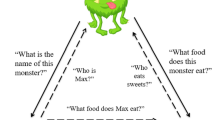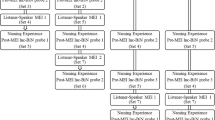Abstract
In two experiments, we tested the effect of multiple exemplar instruction (MEI) for training sets on the emergence of autoclitic frames for spatial relations for novel tacts and mands. In Experiment 1, we used a replicated pre- and post-intervention probe design with four students with significant learning disabilities to test for acquisition of four autoclitic frames with novel tacts and mands before and after MEI. The untaught topographies emerged for all participants. In Experiment 2, we used a multiple probe design to test the effects of the MEI procedures on the same responses in four typically developing, bilingual students. The novel usage emerged for all participants. In the latter experiment, the children demonstrated untaught usage of mand or tact frames regardless of whether they were taught to respond in either listener or speaker functions alone or across listener and speaker functions. The findings are discussed in terms of the role of MEI in the formation of abstractions.
Similar content being viewed by others
References
Albers, A. E., & Greer, R. D. (1991). Is the three-term contingency trial a predictor of effective instruction? Journal of Behavioral Education, 1, 337–354.
Baer, D. M., Wolf, M. M., & Risley, T. R. (1968). Some current dimensions of applied behavior analysis. Journal of Applied Behavior Analysis, 1, 91–97.
Bahadourian, A. J., Tarn, B. K. Y., Greer, R. D., & Rousseau, M. K. (2006). The effects of learn units on student performance in two college courses. International Journal of Behavioral and Consultation Therapy, 2(2), 246–265.
Berens, N. M., & Hayes, S. C. (2007). Arbitrarily applicable comparative relations: experimental evidence for a relational operant. Journal of Applied Behavior Analysis, 40, 45–71.
Cooper, J. O., Heron, T. E., & Heward, H. L. (1987). Applied behavior analysis. Upper Saddle River, NJ: Prentice-Hall.
Emurian, H. H., Hu, X., Wang, J., & Durham, A. G. (2000). Learning Java: A programmed instruction approach using applets. Computers in Human Behavior, 16, 395–422.
Fiorile, C.A. (2005). An experimental analysis of the transformation of stimulus function from speaker to listener and listener to speaker repertoires. Dissertation Abstracts International (UMI No. 3159736).
Genesee, F., Paradis, J., & Crago, M. B. (2004). Dual language development and disorders: A handbook on bilingualism and second language learning. In S. F. Warren, & M. E. Fey, (Eds.), Communication and Language Intervention Series, Vol. 11. Baltimore, MD: Paul H. Brookes Publishing.
Gilic, L. (2005). Development of naming in two-year old children. Dissertation Abstracts International (UMI No.3188740).
Greer, R. D. (2002). Designing teaching strategies: An applied behavior analysis systems approach. Amsterdam: Academic Press.
Greer, R. D., Keohane, D. D., & Healy, O. (2002). Quality and applied behavior analysis. Behavior Analyst Today, 3 (2), 120–132. Retrieved from http://www.behavior-analyst-today.org.
Greer, R. D., & McCorkle, N. P. (2003). CABAS® curriculum and inventory of repertoires for children from preschool through kindergarten (3rd ed.). Yonkers, NY: CABAS®/Fred S. Keller School. (Publication for use in CABAS® schools only).
Greer, R. D., McCorkle, N., & Williams, G. (1989). A sustained analysis of the behaviors of schooling. Behavioral Residential Treatment, 4, 113–141.
Greer, R. D., & McDonough, S. (1999). Is the learn unit the fundamental measure of pedagogy? Behavior Analyst, 20, 5–16.
Greer, R. D., & Ross, D. (2008). Verbal behavior analysis: inducing and expanding new verbal capabilities in children with language delays. Boston, MA: Pearson.
Greer, R. D., Stolfi, L., Chavez-Brown, M., & Rivera-Valdez, C. (2005). The emergence of the listener to speaker component of naming in children as a function of multiple exemplar instruction. The Analysis of Verbal Behavior, 21, 5–26.
Greer, R. D., Stolfi, L., & Pistoljevic, N. (2007). Emergence of naming in preschoolers: A comparison of multiple and single exemplar instruction. European Journal of Behavior Analysis, 8, 119–131.
Greer, R. D., & Yuan, L. (2008). How kids learn to say the darnedest things: The effect of multiple exemplar instruction on the emergence of novel verb usage. The Analysis of Verbal Behavior, 24, 103–121.
Greer, R. D., Yuan, L., & Gautreaux, G. (2005). Novel dictation and intraverbal responses as a function of a multiple exemplar instructional history. The Analysis of Verbal Behavior, 21, 99–116.
Hagopian, L. P., Long, E. S., & Rush, K. S. (2004). Preference assessment procedures for individuals with developmental disabilities. Behavior Modification, 28(5), 668–677.
Hayes, S. C., Barnes-Holmes, D., & Roche, B. (Eds.). (2001). Relational frame theory: A post-Skinnerian account of human language and cognition. New York: Kluwer Academic/Plenum Publishers.
Home, P. J., & Lowe, C. F. (1996). On the origins of naming and other symbolic behavior. Journal of the Experimental Analysis of Behavior, 65, 185–241.
Ingham, P., & Greer, R.D. (1992). Changes in student and teacher responses in observed and generalized settings as a function of supervisor observations of teachers. Journal of Applied Behavior Analysis, 25, 153–164.
Johnston, J., & Pennypacker, H. (1993). Strategies and tactics of human behavioral research (2nd ed.). Hillsdale, NJ: Erlbaum.
Lamarre, J., & Holland, J. (1985). The functional independence of mands and tacts. Journal of the Experimental Analysis of Behavior, 43, 5–19.
Lamm, N., & Greer, R. D. (1991). A systematic replication of CABAS in Italy. Journal of Behavioral Education, 1, 427–444.
Lee, V. L. (1981). Prepositional phrases spoken and heard. Journal of the Experimental Analysis of Behavior, 35, 227–242.
Lee-Park, H. S. (2005). Multiple exemplar instruction and transformation of stimulus function from auditory-visual matching to visual-visual matching. Dissertation Abstracts International (UMI No. 3174834).
Lowe, C. F., & Home, P. J. (1996). Reflections on naming and other symbolic behavior. Journal of the Experimental Analysis of Behavior, 65, 315–340.
Luke, N. M. (2009). The effects of multiple exemplar instruction on the acquisition and abstraction of autoclitic frames for spatial relations in early verbal development. Dissertation Abstracts International (AAT No. 3373793).
Mariano-Lapidus, S. A. (2005). Transfer of stimulus control across vocal and written responses as a function of a multiple exemplar instructional history. Dissertation Abstracts International (UMI No. 3174848).
Matthews, K.M. (2005). Induction of metaphorical responses in middle school students as a function of multiple exemplar instruction. Dissertation Abstracts International (UMI No. 3174851).
Ministère de l’Education nationale (2006–2009). Votre enfant à l’école maternelle. Retrieved February 15, 2009, from http://www.education.gouv.fr/pid35/ecole-maternelle.html.
Murphy, C., & Barnes-Holmes, D. (2009). Establishing derived manding for specific amounts with three children: An attempt at synthesizing Skinner’s verbal behavior with relational frame theory. The Psychological Record, 59, 75–92.
Nirgudkar, A. S. (2005). The relative effects of the acquisition of naming and the multiple exemplar establishing operation experience on the acquisition of the transformation of establishing operations across mands and tacts. Dissertation Abstracts International (UMI No. 3159751).
Nuzzolo-Gomez, R., & Greer, R. D. (2004). Emergence of untaught mands or tacts of novel adjective-object pairs as a function of instructional history. The Analysis of Verbal Behavior, 20, 63–76.
Pistoljevic, N. (2008). The effects of multiple exemplar and intensive tact instruction on the acquisition of naming in preschoolers diagnosed with autism and other language delays. (Doctoral dissertation, Columbia University). Abstract from UMI Proquest Digital Dissertations. (Dissertations Abstract Item: AAT 3317598).
Reed, P., Osborne, L. A., & Corness, M. (2006, December 19). Brief report: The effectiveness of different home-based behavioral approaches to early teaching intervention. Journal of Autism and Developmental Disorders. Retrieved November 11, 2007, from www.springerlink.com/content/3q30031815t32534/fulltext.html.
Selinski, J., Greer, R. D., & Lodhi, S. (1991). A functional analysis of the comprehensive application of behavior analysis to schooling. Journal of Applied Behavior Analysis, 24, 108–118.
Sidman, M. (1994). Equivalence relations and behavior: A research story. Boston, MA: Authors Cooperative.
Skinner, B. F. (1957). Verbal behavior. Acton, MA: Copley Publishing.
Speckman-Collins, J. (2004). Multiple exemplar instruction and the emergence of generative production of suffixes as autoclitic frames. Dissertation Abstracts International (UMI No. 3159757).
Twyman, J. S. (1996). The functional independence of impure mands and tacts of abstract stimulus properties. The Analysis of Verbal Behavior, 13, 1–19.
Waddington, E. M., & Reed, P. (2009). The impact of using the Preschool Inventory of Repertoires for Kindergarten (PIRK®) on school outcomes on children with autism spectrum disorders. Research in Autism Disorders, 3, 809–827.
Wynn, J. W., & Smith, T. (2003). Generalization between receptive and expressive language in young children with autism. Behavioral Interventions, 18, 245–266.
Author information
Authors and Affiliations
Rights and permissions
About this article
Cite this article
Luke, N., Greer, R.D., Singer-Dudek, J. et al. The Emergence of Autoclitic Frames in Atypically and Typically Developing Children as a Function of Multiple Exemplar Instruction. Analysis Verbal Behav 27, 141–156 (2011). https://doi.org/10.1007/BF03393098
Published:
Issue Date:
DOI: https://doi.org/10.1007/BF03393098




